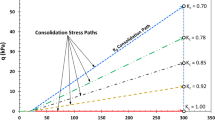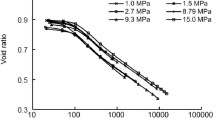Abstract
This study investigated the yielding behavior of natural Lianyungang clay by considering the stress history. A series of drained triaxial tests with different stress paths were conducted on the undisturbed Lianyungang clay under K0-Consolidation. A modified yield function was developed for the natural soft clay, for which the parameter \(\eta _{{K_{0} }}\) was replaced by ηK in the equation for the yield surface from the existing model. The modified equation can describe the effects of stress history and anisotropy on the natural soft clay, and capture the degradation of soil structure. Results showed that the yield surface would rotate clockwise with increasing pre-consolidation stress. As the pre-consolidation stress increases, the slope of the symmetric axis decreases from ηK to close to zero. An exponential equation can be well fitted between the slope of the symmetric axis of the yield surface and the pre-consolidation stress (or over-consolidation ratio, OCR). The effects of stress history and loss of the soil structure are captured well by the modified equation for the yield surface. Angles (θ) between direction of plastic flow under different stress paths and the normal direction of yield surface vary from − 30° to 36°, suggesting the direction of plastic flow in the post-yield state can be described by the associated flow rule.














Similar content being viewed by others
References
Brand EW, Brenner RP (eds) (1981) Soft clay engineering (Vol. 20). Elsevier Scientific Pub, Cambridge
Chandler R (2000) The Third Glossop Lecture: Clay sediments in depositional basins: the geotechnical cycle. Q J Eng GeolHydrogeol 33(1):7–39. https://doi.org/10.1144/qjegh.33.1.7
Cotecchia F, Chandler RJ (2000) A general framework for the mechanical behaviour of clays. Géotechnique 50(4):431–447. https://doi.org/10.1680/geot.2000.50.4.431
Leroueil S, Vaughan PR (1990) The general and congruent effects of structure in natural soils and weak rocks. Géotechnique 40(3):467–488. https://doi.org/10.1680/geot.1990.40.3.467
Burland JB (1990) On the compressibility and shear strength of natural clays. Géotechnique 40(3):329–378. https://doi.org/10.1680/geot.1990.40.3.329
Bozzano F, Bretschneider A, Martino S, Prestininzi A (2014) Time variations of the K0 coefficient in overconsolidated clays due to morphological evolution of slopes. Eng Geol 169:69–79. https://doi.org/10.1016/j.enggeo.2013.11.013
Cai Y, Hao B, Gu C, Wang J, Pan L (2018) Effect of anisotropic consolidation stress paths on the undrained shear behavior of reconstituted Wenzhou clay. Eng Geol 242:23–33. https://doi.org/10.1016/j.enggeo.2018.05.016
Mayne PW (1985) Stress Anisotropy Effects on Clay Strength. J Geotech Eng 111(3):356–366. https://doi.org/10.1061/(asce)0733-9410(1985)111:3(356)
Nishimura S, Minh NA, Jardine RJ (2007) Shear strength anisotropy of natural London Clay. Géotechnique 57(1):49–62. https://doi.org/10.1680/geot.2007.57.1.49
Shi J, Qian S, Zeng LL, Bian X (2015) Influence of anisotropic consolidation stress paths on compression behaviour of reconstituted Wenzhou clay. Géotech Lett 5(4):275–280. https://doi.org/10.1680/jgele.15.00113
Toyota H, Takada S, Susami A (2018) Mechanical properties of saturated and unsaturated cohesive soils with stress-induced anisotropy. Géotechnique 68(10):883–892. https://doi.org/10.1680/jgeot.17.p.018
Wang L, Shen K, Ye S (2008) Undrained shear strength of K0 consolidated soft soils. Int J Geomech 8(2):105–113. https://doi.org/10.1061/(ASCE)1532-3641(2008)8:2(105)
Wang Q, Du X, Gong Q (2014) Undrained shear strength of K0 consolidated soft clays under triaxial and plane strain conditions. Int J Appl Mech 6(3):1450032. https://doi.org/10.1142/S175882511450032X
Yu C, Xu Q, Yin Z (2013) Softening response under undrained compression following anisotropic consolidation. Journal of Central South University 20(6):1703–1712. https://doi.org/10.1007/s11771-013-1663-z
Roscoe KH, Schofield AN, Wroth CP (1958) On the yielding of soils. Géotechnique 8(1):22–53. https://doi.org/10.1680/geot.1958.8.1.22
Guo S, Teng Y (2016) Generalized consolidation theory for anisotropic saturated soils. Int J Geomech 16(3):06015009. https://doi.org/10.1061/(ASCE)GM.1943-5622.0000563
Huang M, Liu Y, Sheng D (2011) Simulation of yielding and stress–strain behavior of shanghai soft clay. Comput Geotech 38(3):341–353. https://doi.org/10.1016/j.compgeo.2010.12.005
Karstunen M, Rezania M, Sivasithamparam N, Yin Z (2013) Comparison of anisotropic rate-dependent models for modeling consolidation of soft clays. Int J Geomech 1:115–119. https://doi.org/10.1061/(ASCE)GM.1943-5622.0000267
Kavvadas M, Amorosi A (2000) A constitutive model for structured soils. Géotechnique 50(3):263–273. https://doi.org/10.1680/geot.2000.50.3.263
Kamei T, Sakajo S (1995) Evaluation of undrained shear behaviour of k0 consolidated cohesive soils using elasto-viscoplastic model. Comput Geotech 17:397–417. https://doi.org/10.1016/0148-9062(96)85016-9
Sivasithampara N, Castro J (2015) An anisotropic elastoplastic model for soft clays based on logarithmic contractancy. Int J Numer Anal Meth Geomech 40(4):596–621. https://doi.org/10.1002/nag.2418
Yang C, Liu X, Liu X, Yang C, Carter JP (2015) Constitutive modelling of Otaniemi soft clay in both natural and reconstituted states. Comput Geotech 70:83–95. https://doi.org/10.1016/j.compgeo.2015.07.018
Yildiz A, Uysal F (2016) Modelling of anisotropy and consolidation effect on behaviour of sunshine embankment: Australia. Int J Civil Eng 14(2):83–95. https://doi.org/10.1007/s40999-016-0018-1
Bica A, Luiz Antnio B, Vendramin D, Martins FB, Gobbi F (2008) Anisotropic shear strength of a residual soil of sandstone. Revue Canadienne De Géotechnique 45(3):367–376. https://doi.org/10.1139/T07-098
Cui YJ, Delage P, Sultan N (2010) Yielding and plastic behaviour of Boom clay. Géotechnique 60(9):657–666. https://doi.org/10.1680/geot.7.00142
Díaz-Rodríguez JA, Leroueil S, Alemán JD (1992) Yielding of Mexico City clay and other natural clays. J Geotech Eng 118(7):981–995. https://doi.org/10.1061/(ASCE)0733-9410(1992)118:7(981)
Graham J, Li E (1985) Comparison of natural and remolded plastic clay. J Geotech Eng 111(7):865–881. https://doi.org/10.1061/(ASCE)0733-9410(1985)111:7(865)
Memarzadeh I, Lashkari A, Shourijeh PT (2017) Consolidation behavior of structured clayey soils: a case study on shiraz fine alluvial strata. Int J Civil Eng 16:1435–1444. https://doi.org/10.1007/s40999-017-0163-1
Mitchell RJ (1970) On the yielding and mechanical strength of Leda clays. Can Geotech J 7(3):297–312. https://doi.org/10.1139/t70-036
Norouzi N, Lashkari A (2021) An anisotropic critical state plasticity model with stress ratio-dependent fabric tensor. Iran J Sci Technol-Trans Civil Eng 45:2577–2594. https://doi.org/10.1007/s40996-020-00448-z
Roscoe KH, Thurairajah A, Schofield AN (1963) Yielding of clays in states wetter than critical. Géotechnique 13(3):211–240. https://doi.org/10.1680/geot.1963.13.3.211
Salimi MJ, Lashkari A (2020) Undrained true triaxial response of initially anisotropic particulate assemblies using CFM-DEM. Comput Geotech 124:103509. https://doi.org/10.1016/j.compgeo.2020.103509
Seah TH, Koslanant S (2003) Anisotropic consolidation behavior of soft bangkok clay. Geotech Test J 26(3):266–276. https://doi.org/10.1520/GTJ11300J
Sivakumar V, Doran IG, Graham J, Johnson A (2001) The effect of anisotropic elasticity on the yielding characteristics of overconsolidated natural clay. Can Geotech J 38(1):125–137. https://doi.org/10.1139/cgj-38-1-125
Smith PR, Hight DW, Jardine RJ (1992) The yielding of Bothkennar clay. Géotechnique 44(2):257–274. https://doi.org/10.1680/geot.1992.42.2.257
Tavenas F, Leroueil S (1977) Effects of stresses and time on yielding of clays. In: Proc. 9th Int. Conf. on Soil Mech. and Found. Engrg., Tokyo, Japan, 1: 319–326
Wong PKK (1975) Yielding and plastic flow of sensitive cemented clay. Géotechnique 25(4):763–782. https://doi.org/10.1680/geot.1975.25.4.763
Graham J, Noonan ML, Lew KV (1983) Yield states and stress-strain relationships in a natural plastic clay. Can Geotech J 20(3):502–516. https://doi.org/10.1139/t83-058
Wheeler SJ, Näätänen A, Karstunen M, Lojander M (2003) An anisotropic elastoplastic model for soft clays. Can Geotech J 40(2):403–418. https://doi.org/10.1139/T02-119
BS1377, Part2 (1990). Methods of test for Soils for civil engineering purposes. British Standards Institution. London. UK
ASTM (2020) Standard Test Method for Consolidated Drained Triaxial Compression Test for Soils. ASTM D7181–20, West Conshohocken, PA.
Nakano M, Nakai K, Noda T, Asaoka A (2005) Simulation of shear and one-dimensional compression behavior of naturally deposited clays by super/subloading yield surface cam-clay model. Soils Found 45(1):141–151. https://doi.org/10.1016/j.soildyn.2004.08.005
Acknowledgements
This study was financially supported by the National Natural Science Foundation of China (No. 41402251 and No. 51978315), which are highly appreciated. The opinions, findings, conclusions, or recommendations expressed herein are those of the authors and do not necessarily represent the views of the sponsors.
Author information
Authors and Affiliations
Corresponding author
Ethics declarations
Conflict of interest
We declare that we have no financial and personal relationships with other people or organizations that can inappropriately influence our work, there is no professional or other personal interest of any nature or kind in any product, service and/or company that could be construed as influencing the position presented in, or the review of, the manuscript entitled.
Supplementary Information
Below is the link to the electronic supplementary material.
Rights and permissions
About this article
Cite this article
Geng, W., Kumah, D., Yin, J. et al. Yielding Behavior of Natural Clay Considering Stress History Subjected to K0-Consolidation. Int J Civ Eng 21, 149–158 (2023). https://doi.org/10.1007/s40999-022-00737-w
Received:
Revised:
Accepted:
Published:
Issue Date:
DOI: https://doi.org/10.1007/s40999-022-00737-w




